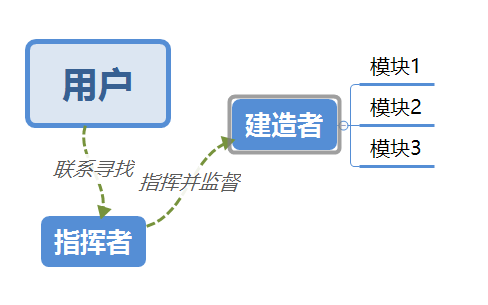Conceptual Interpretation

Text Interpretation: Separates the construction of a complex object from its representation so that the same construction can create different representations.That is, if we use the builder model, then the user needs to specify the type of building to get them, and the process and details of the building need not be clear.The builder model is actually a commander, a builder, and a customer who uses the commander to tell the builder what the result of the construction was.
Builder mode is mainly used to construct a complex object step by step, in which step is a stable algorithm, while the parts of a complex object are constantly changing, and the idea of "division is union" is understood.
Simulative interpretation: For example, the builder goes to a contractor to direct the construction team to complete the building and deliver it to the builder.
Effect
- Create a complex object step by step.
- Decouple the packaging process and the components created.
- You don't need to care how the components are assembled.
Matters needing attention
- A stable algorithm to support
- Processing process is exposed
Code Practice
-
code implementation
//$.ajax() belongs to the constructor mode, where the basic parameters are its builder and.Ajax is its commander. $.ajax({ url:'', method:"", success:function(){ }, }) -
Don't feel clear yet?
Let's try another scenario, like when we want to create a class of candidates who belong first to humans, then add different attributes, which we refine into different builders (classes) to unify.
//The method that individualizes each instantiated object requires this declaration var Human=function(param){ this.skill=param&¶m.skill||'secrecy'; this.hobby=param&¶m.hobby||'secrecy'; } //Human prototypes, common attributes and method suggestions are written in the prototype Human.prototype={ getSkill:function(){ return this.skill; }, getHobby:function(){ return this.hobby; } } var Named=function(name){ var that=this; //constructor (function(name,that){ that.wholeName=name; if(name.indexOf(" ")>-1){ that.firstname=name.slice(0,name.indexOf(" ")); that.lastname=name.slice(name.indexOf(" ")); } })(name,that) } //Instantiate Job Class: Expand Knowledge Points: //1 You need to define that to avoid confusion with this; 2 switch followed by no colon //break in 3 switch is necessary for subsequent statements not to be executed after the statement meets the criteria //4 Recommend writing default in switch to handle default values for exceptions var Work=function(work){ var that=this; //constructor //The constructor sets the corresponding position and description by passing in the position characteristics (function(work,that){ switch(work){ case 'code':that.work='Engineer'; that.workDesc='Immerse in programming every day'; break; case 'ui':that.work='Designer'; that.workDesc='Design is an art'; break; default:that.work=work; that.workDesc="I don't know your job description yet"; } })(work,that) } Work.prototype.changeWork=function(work){ this.work=work; } Work.prototype.changeDesc=function(desc){ this.workDesc=desc; } //Create a class for candidates function Person=function(name,work){ var _person=new Human(); _person.name=new Named(name); _person.work=new Work(work); return _person; } var xiaoli=new Person('xiao li','code'); // Detecting attributes and methods console.log(xiaoli.skill); console.log(xiaoli.work.work); xiaoli.work.changeWork("ui"); console.log(xiaoli.work.work); console.log(xiaoli.firstname);
Expand
- Differences from engineering models
1. It can be distinguished from code samples that factory mode gives the product name and gives the result directly, while builder mode requires the user to participate in the construction process and specify parameters.
2. The construction process of the builder model is more complex than that of the factory, and is done step by step in modules, which may require a small class or constructor for each module part.